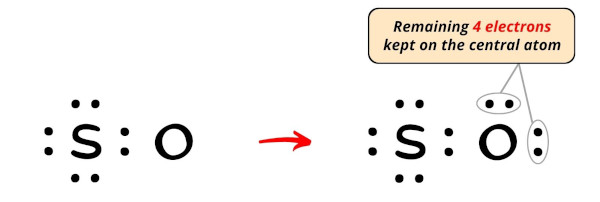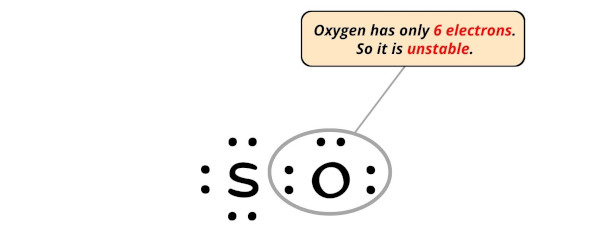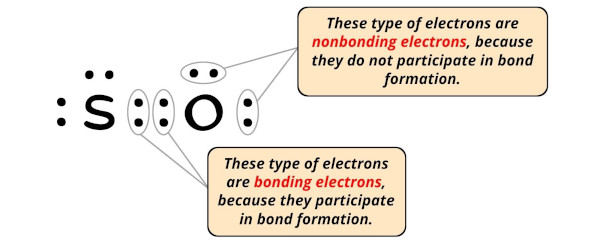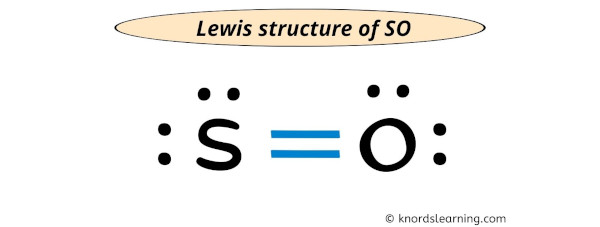
Ready to learn how to draw the lewis structure of SO?
Awesome!
Here, I have explained 6 simple steps to draw the lewis dot structure of SO (along with images).
So, if you are ready to go with these 6 simple steps, then let’s dive right into it!
Lewis structure of SO (Sulfur monoxide) contains one double bond between the Sulfur (S) and Oxygen (O) atom. The Sulfur and Oxygen atoms have two lone pairs on them.
Let’s draw and understand this lewis dot structure step by step.
(Note: Take a pen and paper with you and try to draw this lewis structure along with me. I am sure you will definitely learn how to draw lewis structure of SO).
6 Steps to Draw the Lewis Structure of SO
Step #1: Calculate the total number of valence electrons
Here, the given molecule is SO (Sulfur monoxide). In order to draw the lewis structure of SO, first of all you have to find the total number of valence electrons present in the SO molecule.
(Valence electrons are the number of electrons present in the outermost shell of an atom).
So, let’s calculate this first.
Calculation of valence electrons in SO
- For Sulfur:

Sulfur is a group 16 element on the periodic table. [1]
Hence, the valence electrons present in sulfur is 6 (see below image).

- For Oxygen:

Oxygen is also a group 16 element on the periodic table. [2]
Hence, the valence electron present in oxygen is also 6 (see below image).

Hence in a SO molecule,
Valence electrons given by Sulfur (S) atom = 6
Valence electrons given by Oxygen (O) atom = 6
So, total number of Valence electrons in SO molecule = 6 + 6 = 12
Step #2: Select the center atom
While selecting the atom, you have to put the least electronegative atom at the center.
But here in the SO molecule, there are only two atoms. So you can consider any of the atoms as a center atom.

So, let’s assume that the oxygen atom is a central atom.
Step #3: Put two electrons between the atoms to represent a chemical bond
Now in the above sketch of SO molecule, put the two electrons (i.e electron pair) between the sulfur atom and oxygen atom to represent a chemical bond between them.

This pair of electrons present between the Sulfur (S) atom and Oxygen (O) atom forms a chemical bond, which bonds both the sulfur atom and oxygen atom with each other in a SO molecule.
Step #4: Complete the octet (or duplet) on outside atom. If the valence electrons are left, then put the valence electrons pair on the central atom
Don’t worry, I’ll explain!
In the Lewis structure of SO, we have just assumed the oxygen atom as a central atom and so the sulfur atom is an outer atom.
So now, we have to complete the octet on this sulfur atom.

Now, you can see in the above image that the sulfur atom forms an octet.
Also, only 8 valence electrons of SO molecule are used in the above structure.
But there are total 12 valence electrons in SO molecule (as calculated in step #1).
So the number of electrons left to be kept on the central atom = 12 – 8 = 4.
So let’s keep these four electrons (i.e 2 electron pairs) on the central atom (i.e oxygen atom).

Now, let’s move to the next step.
Step #5: Check whether the central atom has octet or not. If it does not have an octet, then move the electron pair from the outer atom to form a double bond or triple bond
In this step, we have to check whether the central atom (i.e oxygen atom) has an octet or not.
In simple words, we have to check whether this Oxygen (O) atom is having 8 electrons or not.

As you can see from the above image, this oxygen atom has only 6 electrons. So it does not fulfill the octet rule.
Now, in order to fulfill the octet of this oxygen atom, we have to move the electron pair from the outer atom (i.e sulfur atom) to form a double bond.

Now you can see from the above image that the oxygen atom has 8 electrons. So it fulfills the octet rule and it is stable.
Step #6: Final step – Check the stability of lewis structure by calculating the formal charge on each atom
Now, you have come to the final step and here you have to check the formal charge on the sulfur and oxygen atom.
For that, you need to remember the formula of formal charge;
Formal charge = Valence electrons – Nonbonding electrons – (Bonding electrons)/2

- For Sulfur:
Valence electron = 6 (as it is in group 16)
Nonbonding electrons = 4
Bonding electrons = 4 - For Oxygen:
Valence electron = 6 (as it is in group 16)
Nonbonding electrons = 4
Bonding electrons = 4
| Formal charge | = | Valence electrons | – | Nonbonding electrons | – | (Bonding electrons)/2 | ||
| S | = | 6 | – | 4 | – | 4/2 | = | 0 |
| O | = | 6 | – | 4 | – | 4/2 | = | 0 |
So you can see above that the formal charge on sulfur and oxygen atoms are “zero”.
Hence, there will not be any change in the above structure and the above lewis structure of SO is the final stable structure only.
Each electron pair (:) in the lewis dot structure of SO represents the single bond ( | ). So the above lewis dot structure of SO can also be represented as shown below.

Related lewis structures for your practice:
Lewis Structure of XeCl2
Lewis Structure of SeF2
Lewis Structure of C2F2
Lewis Structure of XeCl4
Lewis Structure of AlBr3
Article by;
Jay is an educator and has helped more than 100,000 students in their studies by providing simple and easy explanations on different science-related topics. With a desire to make learning accessible for everyone, he founded Knords Learning, an online learning platform that provides students with easily understandable explanations.
Read more about our Editorial process.
